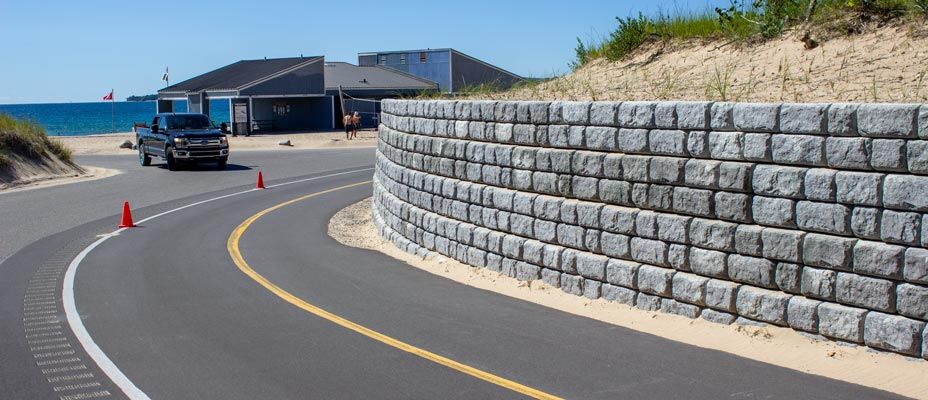What is a gravity retaining wall?

Avg. Read Time: 2 min, 45 sec
Gravity retaining walls are commonly used in civil engineering and landscaping to create terraces, level ground for construction, prevent erosion, or provide support to roadways, bridges, parking areas, trails, and other structures. Gravity walls can be built vertically or with setbacks (also known as the “batter angle”) and rely on their weight and mass to resist the lateral pressure exerted by the material they retain. Redi-Rock gravity walls are constructed with large wet cast concrete blocks weighing a few hundred to several thousand pounds. Other gravity walls may be made from materials like boulders, dry cast concrete blocks, wood, stone-filled wire baskets (gabion baskets), or various pile systems.
The Base Course
Short on time? Here are this article’s key takeaways…
Gravity retaining walls can be used for a variety of land control and protection applications, including the creation of terraces, leveling ground for construction, preventing erosion, or providing support to roadways, bridges, parking areas, trails, and other structures.
Gravity walls can be built vertically or with setbacks (also known as the “batter angle”) and rely on their weight and mass to resist the lateral pressure exerted by the material they retain. Redi-Rock gravity walls can achieve design heights over 20 ft (6 m) in certain scenarios without tiebacks.
Gravity walls require minimal excavation behind the proposed wall site, allowing them to be installed in small project footprints.
If installed properly and maintained well, a wet cast concrete gravity wall can be counted on to provide 75-100 years of service.
Gravity walls are often employed in situations where the height of the wall is relatively low to moderate, though Redi-Rock gravity walls can achieve design heights over 20 ft (6 m) in certain scenarios without tiebacks. Beyond this height, other types of retaining walls such as mechanically stabilized earth (MSE), or reinforced, walls may be more suitable due to increased lateral pressure.
The key features of gravity walls that make them different from other retaining wall solutions include:
- Massive Structure. Gravity retaining walls are typically constructed using heavy materials such as concrete, stone, or masonry blocks. This mass provides stability and resistance against the lateral pressure exerted by the retained material.
- Self-Supporting. Gravity walls rely on their own weight and mass to resist the forces acting upon them. They do not require additional reinforcement, such as tiebacks or anchors, to maintain stability.
- Bigger Base Blocks. The blocks found near the base of a gravity retaining wall are typically the largest featured in the wall. This broader base distributes the weight of the wall over a larger area, reducing the pressure on the underlying soil and enhancing stability. Block size can be reduced as the wall gets taller to keep costs lower without compromising the strength of the wall.
- Flexibility to Fit. Gravity retaining walls can be designed in various shapes and configurations to suit the specific needs of a site. They are also popular choices for tight project sites because they can be installed without reinforcement and the requisite excavation required. Finally, gravity walls can be curved, cornered, stepped, or terraced to accommodate changes in terrain or to deliver a desired appearance.
- Longer Life. Because of the importance of weight and mass in their execution, gravity walls are constructed from strong, durable materials such as concrete or stone and are designed to withstand the elements and provide long-term stability. The simplicity of their design also means fewer components to fail. If installed properly and maintained well, a gravity wall can be counted on to provide 75-100 years of service.
- Cost-Effective. Compared to some other types of retaining walls that may require extensive reinforcement or specialized construction techniques, gravity retaining walls can be more cost-effective to build and maintain.
Collectively, these factors make gravity retaining walls increasingly popular choices for many residential, commercial, and public projects that demand installation efficiency, cost-effectiveness, long-term performance, and aesthetic appeal.